|
|
|||
|
(Back to Preceding Week; on to Next Week) |
|
GIANT STAG BEETLE:
Recently an Internet listserv for bird banding carried a thread in which banders tried to one-up each other over which bird-in-a-mist-net had inflicted the most painful bite. Things started out small with complaints about the annoying habit of chickadees and titmice to attack one's cuticles and quickly moved to tales of more distressing bites from Northern Cardinals, Evening Grosbeaks, and Northern Shrikes. Then tropical biologists leapt into the fray with frightening tales of blood being drawn by hooked bills (and talons) of cockatoos and parrots. We thought about such agony this week at Hilton Pond Center when we got the dickens pinched out of our finger not by a bird but a Giant Stag Beetle. OUCH!
All text & photos © Hilton Pond Center We've commented before about the non-selective nature of mist nets we unfurl to catch birds around Hilton Pond and how we sometimes capture other aerial animals such as bats and butterflies. We were a bit surprised this week, however, when in broad daylight we snared a creature more likely to be seen flying around a porch light at night. Fortunately, we observed this big beetle hit the net and hurried to get it BEFORE it had opportunity to become tightly enmeshed; unfortunately, the beetle was therefore free enough to twist and turn and use its gigantic, inch-long, sharply pointed mandibles (above) to clamp down on a sensitive fingertip. OUCH! We'd rather be nipped by a cardinal.
The Giant Stag Beetle, Lucanus elaphus, is a relatively uncommon resident of the southeastern U.S. as far west as Oklahoma. Its technical name comes appropriately from two Greek words for a kind of beetle and a male deer (or stag) that has antlers shaped like the enlarged mouthparts of the male Giant Stag Beetle. (Incidentally, this insect is sometimes incorrectly called "Elephant Beetle" when people misinterpret its species name.)
Eventually the grub forms a non-feeding pupal stage, with adults emerging in late May and June; they seek mates and dine on sugary liquids such as fruit juice, tree sap, or aphid honeydew. Despite his impressive toothed mandibles (above), the male is unable to use his other mouthparts to chew--nor is the female. Perhaps because their diet is energy-rich but completely lacking in protein and fat, adults die in about a month.
As members of the Stag Beetle Family (Lucanidae), Giant Stag Beetles can be distinguished from other large beetles by examining their paired antennae (see two photos just above). In lucanids these structures are distinctly elbowed and the four terminal oval-shaped segments are separated and inflexible; they do not fold together as in Scarab Beetles.
All text & photos © Hilton Pond Center One reason a Giant Stag Beetle can make a mess of a mist net is because its antennae, huge mandibles, wing covers, and legs all get caught on strands of mesh. And, since it has six of the latter, that's a lot of appendages flapping around getting snared. While we had our macro lens set up to photograph the beetle's antennae we decided to look at its legs and found each was tipped by an impressive pair of tarsal claws (above)--curved just right to capture net strands. Enhancing its ability to get caught were the beetle's "empodia," tiny forked structures that lie behind and between the tarsal claws. Again from past experience at Hilton Pond Center, we know male Giant Stag Beetles can cling to mist nets AND to human skin with decurved tarsal claws--all the better to grab hold of a bird bander's fingertips with their mighty antler-like mouthparts. Did we say OUCH?
All text & photos © Hilton Pond Center
Comments or questions about this week's installment?
Thanks to the following fine folks for recent gifts in support of Hilton Pond Center for Piedmont Natural History and/or Operation RubyThroat: The Hummingbird Project. Your tax-deductible contributions allow us to continue writing, photographing, and sharing "This Week at Hilton Pond." (Please see Support if you'd like to make a gift of your own.)
"This Week at Hilton Pond" is written & photographed You may wish to consult our Index of all nature topics covered since February 2000. You can also use our on-line Hilton Pond Search Engine at the bottom of this page. For a free, non-fattening, on-line subscription to |
|
Make direct donations on-line via
Network for Good: |
|
|
Use your PayPal account
to make direct donations: |
|
|
If you like to shop on-line, you please become a member of iGive, through which more than 700 on-line stores from Barnes & Noble to Lands' End will donate a percentage of your purchase price in support of Hilton Pond Center and Operation RubyThroat. For every new member who signs up and makes an on-line purchase iGive will donate an ADDITIONAL $5 to the Center. Please sign up by going to the iGive Web site; more than 150 members have signed up to help. It's a painless, important way for YOU to support our work in conservation, education, and research. |
|
| The highly coveted Operation RubyThroat T-shirt (four-color silk-screened) is made of top-quality 100% white cotton. It highlights the Operation RubyThroat logo on the front and the project's Web address (www.rubythroat.org) across the back.
Now you can wear this unique shirt AND help support Operation RubyThroat: The Hummingbird Project and Hilton Pond Center. Be sure to let us know your mailing address and adult shirt size: Small (suitable for children), Medium, Large, X-Large, or XX-Large. These quality shirts don't shrink! Price ($21.50) includes U.S. shipping. A major gift of $1,000 gets you two Special Edition T-shirts with "Major Donor" on the sleeve. |
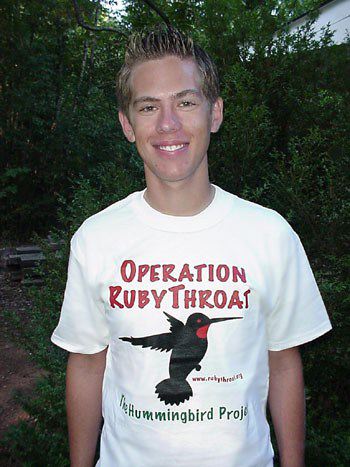
Need a Special Gift for a Want to make a If so, why not use our new handy-dandy on-line Google Checkout below to place your secure credit card order or become a Major Donor today? |
|
|
|
|
SPECIES BANDED THIS WEEK: * = New species for 2008 WEEKLY BANDING TOTAL 23 species 77 individuals YEARLY BANDING TOTAL (2008) 43 species 974 individuals 7 Ruby-throated Hummingbirds 27-YEAR BANDING GRAND TOTAL (since 28 June 1982) 124 species 51,141 individuals NOTABLE RECAPTURES THIS WEEK (with original banding date, sex, and current age) Ruby-throated Hummingbird (6) Carolina Chickadee (2) American Goldfinch (1) Carolina Chickadee (2) Northern Cardinal (2) Eastern Bluebird (1) Tufted Titmouse (1) Carolina Wren (2)
|
OTHER NATURE NOTES OF INTEREST --On 1 Jun we were delighted by a unique occurrence: Two Brown-headed Nuthatches AND two White-breasted Nuthatches caught in the same mist net at the same time. Considering we have banded only 45 BHNU and 17 WBNU in 27 years at Hilton Pond Center, you can understand our excitement. All four nuthatches were recent fledglings, three of which undoubtedly were drawn to the net by vocalizations from the one first caught. (We caught two more BHNU in subsequent days.) --On the evening of 12 Jun we heard loud thunder not far from the Center, so we shut our mist nets in anticipation of heavy wind and rain, finishing just before the electrical storm began. While we gazed out our office window at the deluge, we experienced a lightning strike followed instantaneously by a deafening thunderclap. This dreaded coincidence meant the lightning had hit close--something that happened two summers ago when the giant White Oak beside Hilton Pond took a direct strike. That this year's lightning struck nearby was reinforced as all the lights in the old farmhouse went out and we had to use our trusty oil lamps for illumination. Power was off for about 20 hours but this time the computer network was saved; unfortunately, however, lightning once again blew circuitry on the heating/air conditioning system, so it was a long, hot weekend before the repairman could get parts. We learned our lesson and had the furnace technician install a whole-house surge protector that we hope will minimize electrical damage during future storms; total bill: $600. (For those who have wondered, our big oak tree survives so far but has several dead limbs from the 2006 jolt.) --Ruby-throated Hummingbirds finally began showing up again at Hilton Pond Center this week, with five new birds banded and six returns from previous years (left). This is still our slowest year ever, with only seven RTHU captured through 14 Jun; on average, we have banded 18 by that date, with as many as 39 back in 1997 and 34 last year. More ominous: This time last year we had 42 returns from previous years; in 2008 we've had just seven. Of these, all except one were banded last year, and only one is a hatchling from 2007; i.e., we're seeing very few "old" OR "young" RTHU. All text & photos © Hilton Pond Center
|
|
|
|
(Back to Preceding Week; on to Next Week) Up to Top of Page Back to This Week at Hilton Pond Center Current Weather Conditions at Hilton Pond Center |
 You can also post questions for The Piedmont Naturalist |
Join the |
Search Engine for |
|
|
Fishing Rods

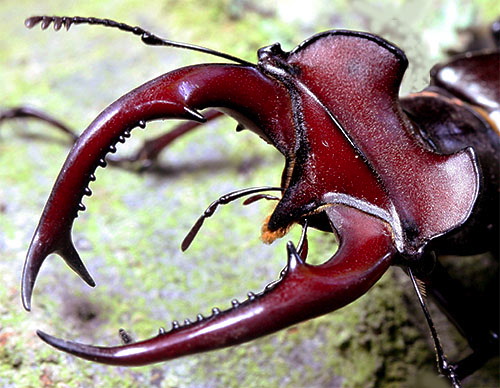

 Like deer, male Giant Stag Beetles battle each other with their "antlers," grasping and flipping opponents until the victor gets to mate with a nearby female (right) who is adorned by much, much smaller mandibles. (Despite the tininess of her mouthparts, the female can still pinch and--we can report from memorable experience--will do so if given half a chance.) Overall, a male Giant Stag Beetle can be a little more than 2" long--half its length is mandibles--while the female is only about 1.5" long and with a head narrower than her thorax. Individuals vary in color from chestnut brown to brownish-black, with the male's head and mandibles being somewhat paler than the rest of his exoskeleton.
Like deer, male Giant Stag Beetles battle each other with their "antlers," grasping and flipping opponents until the victor gets to mate with a nearby female (right) who is adorned by much, much smaller mandibles. (Despite the tininess of her mouthparts, the female can still pinch and--we can report from memorable experience--will do so if given half a chance.) Overall, a male Giant Stag Beetle can be a little more than 2" long--half its length is mandibles--while the female is only about 1.5" long and with a head narrower than her thorax. Individuals vary in color from chestnut brown to brownish-black, with the male's head and mandibles being somewhat paler than the rest of his exoskeleton.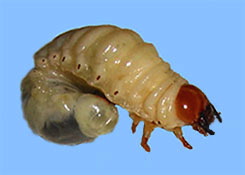 After mating the female Giant Stag Beetle chooses a hardwood snag or stump in which to lay her eggs; this site provides a food-rich home for her larvae for at least 12 months, possibly for multiple years. The white, red-headed grub (left)--which molts through several stages and eventually reaches a length of two inches or so--consumes fungus-enriched, carbohydrate-laden dead wood that is, in turn, digested by symbiotic bacteria and other microbes in its gut. (Dead microbes provide a good source of fats and proteins the grub needs to grow and metamorphose.) Stag beetle larvae--which sometimes occur in large colonies in a particularly rich rotten-wood locale--are true decomposers and do no damage to living trees.
After mating the female Giant Stag Beetle chooses a hardwood snag or stump in which to lay her eggs; this site provides a food-rich home for her larvae for at least 12 months, possibly for multiple years. The white, red-headed grub (left)--which molts through several stages and eventually reaches a length of two inches or so--consumes fungus-enriched, carbohydrate-laden dead wood that is, in turn, digested by symbiotic bacteria and other microbes in its gut. (Dead microbes provide a good source of fats and proteins the grub needs to grow and metamorphose.) Stag beetle larvae--which sometimes occur in large colonies in a particularly rich rotten-wood locale--are true decomposers and do no damage to living trees. 
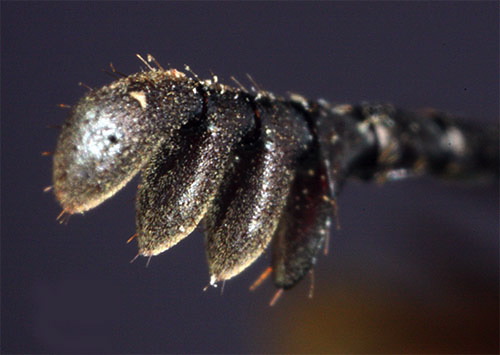
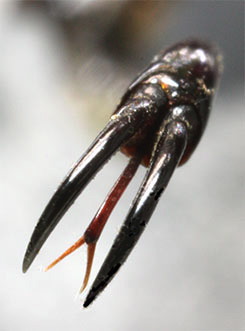
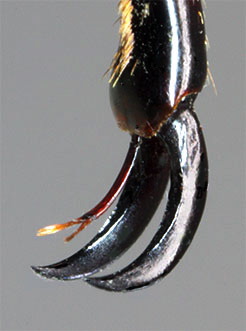


 Please report your
Please report your